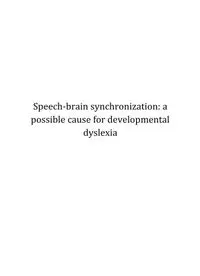Table Of ContentSpeech-brain synchronization: a
possible cause for developmental
dyslexia
The research presented in this thesis was partially supported by: grants
CONSOLIDER-INGENIO2010 CSD2008-00048 and PSI2012-31448 from the
Spanish Ministry of Science and Innovation, the AThEME project funded by the
European Commission 7th Framework Programme and ERC-2011-ADG-295362
from the European Research Council to Dr. Manuel Carreiras; grant PSI2012-
32350 from the Spanish Ministry of Economy and Competitiveness to Dr. Nicola
Molinaro; grant PSI2012-32128 from the Spanish Ministry of Economy and
Competitiveness to Dr. Marie Lallier.
Mikel Lizarazu Ugalde
All right reserved
BCBL
Basque Center on Cognition Brain and Language
Paseo Mikeletegi, 69, Donostia-San Sebastián
November, 2016
Speech-brain synchronization: a
possible cause for developmental
dyslexia
By Mikel Lizarazu Ugalde
A dissertation submitted to the Department of Linguistic and Basque Studies
of the University of the Basque Country in candidacy for the
Degree of Doctor in Linguistics
Thesis Supervised by Dr. Nicola Molinaro and Dr. Marie Lallier
San Sebastian, 2017
(cc)2017 MIKEL LIZARAZU UGALDE (cc by 4.0)
ACKNOWLEDGMENT
The work presented in the thesis was carried out at the “Basque Center on
Cognition Brain and Language” (BCBL), under the supervision of Dr. Nicola
Molinaro and Dr. Marie Lallier.
Firstly, I would like to express my sincere gratitude to Dr. Molinaro and Dr.
Lallier for the continuous support of my Ph.D study and related research, for their
patience, motivation, and immense knowledge. Their guidance helped me in all the
time of research and writing of this thesis. It was a real pleasure to be under their
supervision and learn from them.
Besides my advisor, I would like to thank the rest of my thesis committee:
Prof. Franck Ramus, Prof. Martin Cooke, and Dr. Iria SanMiguel, for their insightful
comments and encouragement, but also for the hard question which incented me
to widen my research from various perspectives.
I thank my fellow lab mates in for the stimulating discussions and for all the
fun we have had in the last five years. My sincere thanks also go to all the
participants and families that took part in the experiments.
Last but not the least, I would like to thank my family: my parents and my
brother, girlfriend and friends for supporting me spiritually throughout writing
this thesis.
ABSTRACT
Dyslexia is a neurological learning disability characterized by the difficulty
in an individual´s ability to read despite adequate intelligence and normal
opportunities. The majority of dyslexic readers present phonological difficulties.
The phonological difficulty most often associated with dyslexia is a deficit in
phonological awareness, that is, the ability to hear and manipulate the sound
structure of language. Some appealing theories of dyslexia attribute a causal role to
auditory atypical oscillatory neural activity, suggesting it generates some of the
phonological problems in dyslexia. These theories propose that auditory cortical
oscillations of dyslexic individuals entrain less accurately to the spectral properties
of auditory stimuli at distinct frequency bands (delta, theta and gamma) that are
important for speech processing. Nevertheless, there are diverging hypotheses
concerning the specific bands that would be disrupted in dyslexia, and which are
the consequences of such difficulties on speech processing.
The goal of the present PhD thesis was to portray the neural oscillatory
basis underlying phonological difficulties in developmental dyslexia.
We evaluated whether phonological deficits in developmental dyslexia are
associated with impaired auditory entrainment to a specific frequency band. In
that aim, we measured auditory neural synchronization to linguistic and non-
linguistic auditory signals at different frequencies corresponding to key
phonological units of speech (prosodic, syllabic and phonemic information). We
found that dyslexic readers presented atypical neural entrainment to delta, theta
and gamma frequency bands. We focused on atypical auditory entrainment to delta
oscillations that might be underlying (i) the reduced sensitivity to prosodic
contours in speech, ii) the encoding difficulties during speech processing and (ii)
the speech-related attentional and phonological deficits observed in dyslexia.
In addition, we characterized the links between the anatomy of the
auditory cortex and its oscillatory responses, taking into account previous
studies which have observed structural alterations in dyslexia. We observed that
the cortical pruning in auditory regions was linked to a stronger sensitivity to
gamma oscillation in skilled readers, but to stronger theta band sensitivity in
dyslexic readers. Thus, we concluded that the left auditory regions might be
specialized for processing phonological information at different time scales in
skilled and dyslexic readers (phoneme vs. syllable, respectively).
Lastly, by assessing both children and adults on similar tasks, we provided
the first evaluation of developmental modulations of typical and atypical auditory
sampling (and their structural underpinnings). We found that atypical neural
entrainment to delta, theta and gamma are present in dyslexia throughout the
lifespan and is not modulated by reading experience.
TABLE OF CONTENTS
Acknowledgment ................................................................................................................................. 7
Abstract.................................................................................................................................................... 9
Abbreviations ......................................................................................................................................13
1 Overview of the work: Summary, Objectives and Studies .......................................... 1
2 Introduction ................................................................................................................................15
2.1 Neuroanatomy of auditory signal processing .......................................................15
2.1.1 Central auditory neural pathway ......................................................................15
2.1.2 The human auditory cortex .................................................................................18
2.1.3 Cortical oscillations during audio signal processing .................................20
2.2 Developmental dyslexia .................................................................................................26
3 Methods ........................................................................................................................................35
3.1 Relevance of the MEG .....................................................................................................35
3.2 What do we measure? ....................................................................................................36
3.3 Instrumentation ................................................................................................................37
3.4 MEG measurements.........................................................................................................38
3.4.1 Source reconstruction ............................................................................................38
3.4.2 Coherence analysis ..................................................................................................41
3.4.3 Phase locking value analysis (PLV) ..................................................................42
3.4.4 Partial direct coherence (PDC) analysis .........................................................43
3.4.5 Mutual information (MI) analysis .....................................................................44
3.4.6 Lateralization index (LI) analysis ......................................................................45
4 Studies ...........................................................................................................................................47
4.1 Study 1: Neural mechanisms underlying speech processing ..........................49
4.1.1 Methods .......................................................................................................................49
4.1.2 Results ..........................................................................................................................56
4.1.3 Discussion ...................................................................................................................60
4.2 Study 2: Out-of-synchrony speech entrainment in developmental dyslexia
65
4.2.1 Results ..........................................................................................................................65
4.2.2 Methods .......................................................................................................................75
4.2.3 Discussion ...................................................................................................................81
4.3 Study 3: Developmental evaluation of atypical auditory sampling in
dyslexia: Functional and structural evidence .....................................................................87
4.3.1 Methods .......................................................................................................................88
4.3.2 Results ..........................................................................................................................98
4.3.3 Discussion ................................................................................................................ 105
5 General discussion ................................................................................................................. 111
6 Conclusions ............................................................................................................................... 123
7 References ................................................................................................................................. 125

